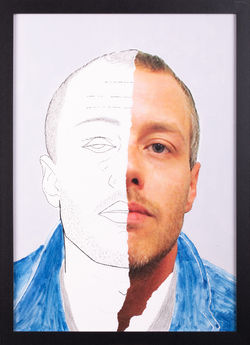PAST: VICTIMS RIGHTS
45x62cm; 32x45cm (3), drawing and collage on paper
Click on the thumbnails to view full image
 Emmanuel Unaji, Past: Victims Rights, Magistrates Association 100 Years of Justice ExhibitionDrawing and collage on paper picturing Stephen Lawrence, his parents and his murderers by Emmanuel Unaji for the magistrates association 100 years of justice exhibition |  Emmanuel Unaji, Past: Victims Rights, Magistrates Association 100 Years of Justice ExhibitionDrawing and collage on paper picturing Stephen Lawrence, his parents and his murderers by Emmanuel Unaji for the magistrates association 100 years of justice exhibition |  Emmanuel Unaji, Past: Victims Rights, Magistrates Association 100 Years of Justice ExhibitionDrawing and collage on paper picturing Stephen Lawrence, his parents and his murderers by Emmanuel Unaji for the magistrates association 100 years of justice exhibition |
|---|---|---|
 Emmanuel Unaji, Past: Victims Rights, Magistrates Association 100 Years of Justice ExhibitionDrawing and collage on paper picturing Stephen Lawrence, his parents and his murderers by Emmanuel Unaji for the magistrates association 100 years of justice exhibition |  Emmanuel Unaji, Past: Victims Rights, Magistrates Association 100 Years of Justice ExhibitionDrawing and collage on paper picturing Stephen Lawrence, his parents and his murderers by Emmanuel Unaji for the magistrates association 100 years of justice exhibition |
ABOUT THE WORK
In Emmanuel's own words
A series of works that examines the morality of the Judicial System, illustrating a case that highlights the uncertainty in which certain demographics of people exist. Begging the question "Who does Lady Justice really serve?"

EMMANUEL UNAJI
Kent, England
Emmanuel Unaji is a British-born Nigerian multimedia fine artist based in London. Combining painting, drawing, collage and fashion design, his style is rebellious and bold. Unaji’s work is principally an exploration of what lies beneath the surface of human existence. The essence of Emmanuel’s work exists within the metaphor of rejecting the inert aesthetic function of the creative within industry. This is a method to re-contextualise the autonomy of an artist and defy the market’s objective reality.
INTERVIEW
We had a short chat with Emmanuel to get to know him better
What has been your creative journey?
When I was a child we went on a family vacation to Rome, and I remember seeing the Sistine Chapel ceiling and questioning the aesthetic, not seeing myself in the art. From a very young age art left me with a lot of questions. My spirit was moved by the Vatican, and as I grew older I started to learn the language of how to express it.
Working in the modelling industry gave me insight into fashion - it’s all about optics, but it’s also contemporary culture. Fashion images are layered with meaning, and it was an opportunity to learn how to deconstruct them.
In 2016 I had my first art exhibition and that was the start of my art career. I realised that I can combine traditional structures with a contemporary ecosystem. Having just graduated from a Fine Art degree at Kingston University, I am now a full time artist. My brother and I run an art and design company UNAJI&Co. We make clothing, but we also work in video and creative consultancy.
What were your early creative influences?
Virgil Abloh was probably the biggest creative influence - his work around 2012-2013 inspired me to pursue this pathway. He referenced Renaissance paintings juxtaposing them with streetwear images. It spoke to me - I knew that was a visual language I could relate to.
I like Barbaba Kruger and text art in general, Basquiat, Liechtenstein and the YBAs… The YBAs specifically because they found their way within the system, they made it their own.
What inspires you to create and how would you describe your process?
I am fascinated by Noam Chomsky’s idea of manufacturing consent. The way that mass media creates our opinions and realities, or how the fashion industry shapes our perception of self.
I start with words - text, a piece of writing or a media headline. It’s difficult to always communicate verbally, so my work is both textual and figurative. Once I select words that grab me, I find an image that encapsulates the concept and I work backwards. I take it apart, illustrate it, dissect it. It’s very symbolic to my process - to take time and deconstruct the information before accepting it as it is. I like to look at all the layers.
What is your preferred medium and why?
I always split faces, it’s a reference to the duality of human expression but also a reference to the inner child in all of us. It’s a juxtaposition of beauty and existentialism.
I love lines! Lines are like words - I never waste lines when I am drawing. I may paint over it, but I don’t want to lose the line. The faintness of the pencil means people have to look closer.
Combining fashion illustration, painting, performance, clothing… I think it is the street spirit - utilising any resource you have available to creatively communicate your message. Each medium is a mode of communication, each one is an additional layer of meaning. I augment the work through clothing. There is an ongoing relationship between the final piece and the white cube of the gallery. Whatever I wear in the space becomes a socio-political performance, initiating further conversations.
What does art mean for you?
Fine art is a language. The metaphysical experience of connecting with a piece of work, the silent conversation between the artist and the viewer. There’s no boundaries in fire art, it brings all the socio-economic and socio-political nuances to the surface. It’s a leveller too because art can connect people beyond the boxes that we are divided into.
My practice looks at the relationship between human commodification and hyper-visible corporate interactions, and I use entrepreneurship as an additional mode for enquiry. Art is the perfect ground to ask questions.